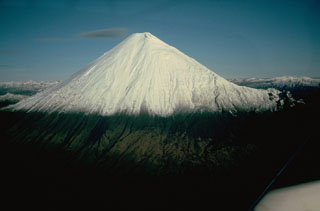Report on Sangay (Ecuador) — 7 February-13 February 2024
Smithsonian Institution / US Geological Survey
Weekly Volcanic Activity Report, 7 February-13 February 2024
Managing Editor: Sally Sennert.
Written by JoAnna G. Marlow.
Please cite this report as:
Global Volcanism Program, 2024. Report on Sangay (Ecuador) (Marlow, J G, and Sennert, S, eds.). Weekly Volcanic Activity Report, 7 February-13 February 2024. Smithsonian Institution and US Geological Survey.
Sangay
Ecuador
2.005°S, 78.341°W; summit elev. 5286 m
All times are local (unless otherwise noted)
IG-EPN reported that high levels of eruptive activity continued at Sangay during 7-13 February. Reported seismicity consisted of 132-458 daily counts of explosive events. Weather clouds prevented views of summit crater activity during 7-9 February. During the morning of 8 February, small pyroclastic flows descended a ravine on the SW flank. Ash-and-gas plumes were observed in webcam images and sometimes satellite images acquired by the GOES-16 satellite during 10-11 and 12-13 February; plumes rose as high as 1.5 km above the crater and drifted SW, WSW, and W. Degassing activity was observed in GOES-16 satellite images during 11-12 February; gas plumes rose as high as 1.8 km above the crater and drifted SW and W. Continuous emissions consisting of gas and low amounts of ash were observed in webcam images at 1645 on 12 February; the emissions rose as high as 2.2 km above the crater and drifted WSW. The webcam monitoring system occasionally recorded episodes of crater incandescence during the night and early morning hours. Avalanches of incandescent material descended the SW flank as far as 1.5 km from the summit during the nights and early mornings of 7-8, 9-10, and 12-13 February. Secretaría de Gestión de Riesgos (SGR) maintained the Alert Level at Yellow (the second highest level on a four-color scale).
Geological Summary. The isolated Sangay volcano, located east of the Andean crest, is the southernmost of Ecuador's volcanoes and its most active. The steep-sided, glacier-covered, dominantly andesitic volcano grew within the open calderas of two previous edifices which were destroyed by collapse to the east, producing large debris avalanches that reached the Amazonian lowlands. The modern edifice dates back to at least 14,000 years ago. It towers above the tropical jungle on the east side; on the other sides flat plains of ash have been eroded by heavy rains into steep-walled canyons up to 600 m deep. The earliest report of an eruption was in 1628. Almost continuous eruptions were reported from 1728 until 1916, and again from 1934 to the present. The almost constant activity has caused frequent changes to the morphology of the summit crater complex.
Sources: Instituto Geofísico-Escuela Politécnica Nacional (IG-EPN), Secretaría de Gestión de Riesgos (SGR)

